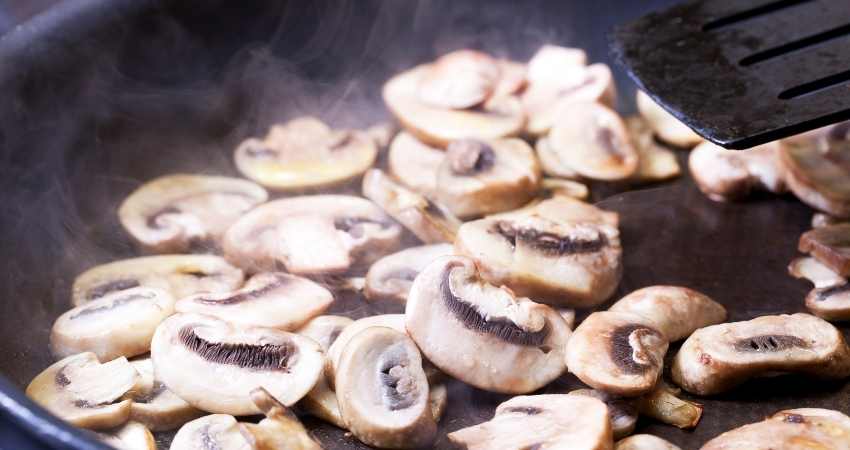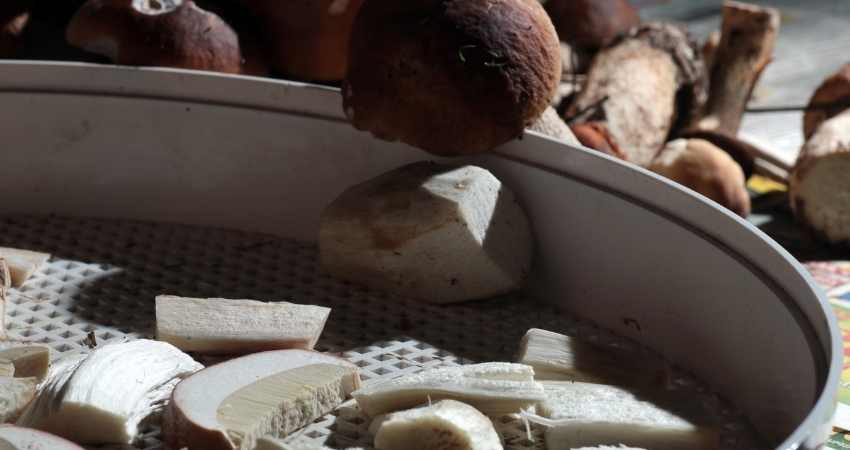The Best Way To Store Mushroom
I always have mushrooms in my refrigerator. During my Health Coaching sessions, clients sometimes ask me about mushroom storage. I’m going to inform you the best way to store mushrooms.
The best way to store mushrooms short term is in the refrigerator. Place them into a bowl, cover them with plastic wrap, poke a few small holes in the wrap and refrigerate up to a week. For longer-term storage, steam the mushrooms, place them into freezer bags and store them in the freezer up to one year.
In this article, we’re going in-depth on each of the methods discussed above. I will take a look at why you should never freeze fresh mushrooms. In addition, I’ll discuss how to tell whether or not your mushrooms turned bad, something you’ll need to know before storing them.
Best Ways To Store Mushrooms

I’ve briefly touched on the best ways to store mushrooms. Therefore, we’re taking a deeper look into it. I’ve made a step-by-step guide for each of the different ways you can store mushrooms.
I’ll talk about the two different types of ways in which you should freeze mushrooms if you’re keeping them for longer than a week. Both methods are used for two different types of reasons and each one has a pro and a con which I will tell you about. It’s important to choose the method that best suits you.
With that being said, let’s start off by talking about storing mushrooms in the refrigerator.
Refrigerate Mushrooms
If you just bought your mushrooms and you know you’re going to use them within a week, this is the best method to use1. It’s even better to do this than to leave the mushrooms in their original packaging.
Step-by-step guide. The best way to refrigerate mushrooms:
- Place the mushrooms in a bowl.
- Use plastic wrap to cover the mushrooms and seal the bowl.
- Use a toothpick to poke three or four holes in the plastic wrap.
- Put the covered mushrooms in the refrigerator.
- Store them for up to one week.
I recommended using a toothpick to make the holes in the plastic wrap because you want the holes to be as small as possible. Another thing that works great is a fork but just use the tips of the fork. When using a fork, make two sets of holes, and you should be good.
Disclaimer: Some links in this post are affiliate links. This means if you click them and make a purchase, I’ll receive a small commission at no extra cost to you.
Freeze Mushrooms Sautéed
This method of freezing mushrooms involves sautéing them first. While this method doesn’t have any drawbacks, it’s less healthy than steaming your mushrooms but much more flavorful.
How to freeze sautéed mushrooms:
- Saute the mushrooms in a little bit of olive oil over high heat.
- Cook them for about five minutes until most of the liquid has evaporated.
- Place the mushrooms into a strainer.
- Cover the strainer with a cloth or paper towel.
- Let the mushrooms completely cool down.
- Spread the cooled mushrooms on a cookie sheet, so they are not touching each other.
- Place the cookie sheet into the freezer until the mushrooms are completely frozen.
- Place the frozen mushrooms into a freezer bag or container.
- Remove as much air as possible from the bag or container.
- Store in the freezer up to a year.
To remove as much air as possible from the freezer bag, it’s best to use a vacuum sealer. If you don’t have a sealer, squeeze as much air out as possible and then use a straw to suck the remaining air out through a small hole before closing it completely ((National Center for Home Food Preservation: Freezing Mushrooms)).
A vacuum sealer is one of those items you’d wonder how you did without after purchasing one. I own and use one made by FoodSaver. They sell a variety of affordable ones on Amazon which you can check out by clicking here, vacuum sealers.
If using a container, leave a 1/2 inch of space at the top of the container. Use Tupperware specifically for freezing. It’s best to sauté the mushrooms in olive oil, and you can use a few herbs to add more flavor.

Freezing Steamed Mushrooms
The biggest drawback to freezing steamed mushrooms is, once thawed they won’t be as flavorful. Although freezing steamed mushrooms leaves them in a healthier state than by sautéing them.
How to freeze steamed mushrooms:
- Put a pot of water on the stove and bring to a boil.
- Put the mushrooms into a steamer and steam for three to five minutes.
- Remove the mushrooms and place them into a strainer.
- Let the mushrooms cool down completely.
- Spread the cooled mushrooms on a cookie sheet, so they are not touching each other.
- Place the cookie sheet into the freezer until the mushrooms are completely frozen.
- Place the frozen mushrooms into a freezer bag or container.
- Remove as much air as possible from the bag or container.
- Store in the freezer up to a year.
For both methods, there’s a good reason why a strainer should be used when they’re cooling down((Texas Agricultural Extension Service: Home Food Storage)). The drier the mushroom before freezing the better.
Further down in the article you’ll better understand why in the section about freezing fresh mushrooms.
In addition, have you been eating mushrooms without cooking them? You may want to check out my article, Can Mushrooms Be Eaten Raw? A Scientific Look.
Best Container To Store Mushrooms
The best container to store mushrooms in a refrigerator is a bowl, covered in plastic with small vent holes in the top. The best container for a freezer is an airtight container or freezer bag.
When you place your mushrooms in a sealed container, they have a greater chance of going bad quicker. This happens because condensation can build up inside the container and make the mushrooms mushy.
Should Mushrooms Be Refrigerated?
Mushrooms should be refrigerated and can be stored in the fridge up to one week. If mushrooms are kept out of the refrigerator, in room temperature, they will go bad faster.
Once you get home from the supermarket, the sooner you put the mushrooms in the fridge the better2. A mushroom is a fungus3 that thrives in a warmer climate and high humidity. It’s one of the first things I put away.
Can You Freeze Fresh Mushrooms For Later Use?
You can freeze fresh mushrooms for later use, but their structure will deteriorate and become mushy. A mushroom is made mostly of water and once it’s frozen, the water crystallizes and separates the mushroom at the cellular level.
If you’re saving the fresh mushrooms to make a mushroom sauce, this may be okay and won’t matter much. If you’re going to use the mushrooms as they are, it’s better to steam or sauté them first.They can be frozen up to one year ((USDA: Freezing and Food Safety)).
How To Tell If A Mushroom Is Bad
If you don’t store mushrooms properly, there is a greater risk of opening the mushrooms and finding out they’ve gone bad. Therefore, you may be wondering, how to tell if a mushroom is bad.
Tell if a mushroom is bad is by sight, touch or smell. The following are ways to tell if a mushroom is bad:
- The mushroom has turned dark and has spots.
- The mushroom has become wrinkled looking from drying out.
- The mushroom surface has become slimy.
- The mushroom is emitting a would odor.
Bad mushrooms can be dangerous and make you sick. If you’re unsure if they’re bad, you’re better off discarding them and buying some new ones ((USDA: Mushrooms)).
Or, if you make your own compost, adding old mushrooms are beneficial for it. They have tons of nutrients like phosphorous, potassium, selenium and copper ((Oregon State University: What is mushroom compost?)).
If you have any questions to ask me about this article don’t hesitate to comment below or email us. You can find an email on our contact page.
Read Next – More Food Storage
This Is How To Store Baked Tofu
This Is How To Preserve Cut Papaya
This Is The Best Way To Store Cauliflower
This Is The Guide To Store Garlic Properly For Best Results
